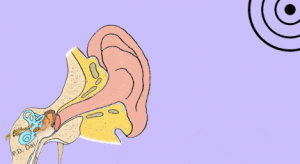
Some people say that modern people’s sense of security is given by earphones: when walking on the road, riding the subway, sitting in front of a computer… even when sleeping, they must wear earphones.
Experts say that when headphones are used for a long time, sound pressure is concentrated on the tympanic membrane, which can cause auditory fatigue easily, especially in a noisy environment. People will unconsciously increase the volume of the headphones. The hair cells are damaged, causing ear pain, tinnitus, hard of hearing and even hearing loss.
What’s more serious is that hair cells do not have the ability to regenerate like other cells. Their number is fixed. Once the cells die, the hearing damage will be permanent.

An EU survey report stated that if the earphone sound exceeds 85 decibels and lasts longer than 30 minutes, it may cause temporary hearing loss; if the earphone volume exceeds 89 decibels and is used for more than 1 hour a day, it may cause permanent hearing loss for 5 years.
According to the World Health Organization, about 1.1 billion young people (12 to 35 years old) in the world are facing irreversible hearing loss due to excessive volume of personal audio equipment (for example: wearing headphones for a long time to listen to music/sweeping dramas/short videos, etc.).
Which earphone is more ear-friendly?
Sometimes it’s work needs, and sometimes it’s hobbies. For many people, the use of headphones is “just needed”.
There are 4 types of common earphones in terms of wearing categories: in-ear (earplugs), head-mounted (over-ear), semi-in-ear, and bone conduction.
What are the advantages and disadvantages of different earphones, and what are the differences in their health effects?
Ear hook type, semi-ear type
The impact on the ears is small. It does not form a closed space with the ears, so half of the sound flows into the ears and half goes out. Therefore, its sound insulation effect is often not good, but it will not swell after wearing it for a long time.
Bone conduction
Relatively speaking, the hazard is much less, because it opens both ears and uses the skull to directly transmit sound. However, even with bone conduction headphones, the sound cannot be turned to a high level, which will also accelerate the loss of the cochlea. Although it won’t feel swollen and uncomfortable after wearing it for a long time, it may cause ears to suffer from hanging.

Head-mounted
Divided into open and closed. The open type usually has a large and comfortable sound field and is not tired for a long time.
Although the head-mounted type does not have the advantage of being compact and portable, it has good sound effects. Most importantly, since it is not worn in the ear, it will hardly cause damage to the ear canal and eardrum.
In-ear
In a very noisy environment, people will turn up the volume unconsciously. In order to maintain a high volume without knowing it in order to be consistent with the outside world, it is the easiest to hurt your ears. The in-ear type is a closed space, and the pressure in the ear must be greater than that of the open-type earphone, so the in-ear type has the greatest impact on the ear.
Frequently used in-ear earplugs may also become a breeding ground for bacteria, which can easily swell the stratum corneum of the skin of the external auditory canal and block the hair follicles, leading to long-term chronic congestion, stimulating the excessive secretion of cerumen glands, and increasing earwax. Tinnitus, hearing loss, dizziness and other symptoms.
6 things to learn before wearing headphones

01. Learn to choose headphones
When choosing a headset, you should choose a good material, good sound quality, and appropriate size, especially for people who are allergic to certain materials and need to be more cautious in choosing.
Use in-ear earplugs to choose a rubber sleeve that matches the size of the ear. If it is too large, it will cause discomfort or ear canal inflammation. If it is too small, it will not have a noise reduction effect. There is no uniform standard for this. Try it yourself. It is better to wear it comfortably.
02. Pay attention to hygiene
Pay attention to keeping the earplugs clean during use, and it is best to clean them in time after each use to avoid the breeding of bacteria.
People with “oily ear canals” should change new rubber sleeves regularly. Poor quality rubber sleeves are prone to swelling and deformation when immersed in oil for a long time, and it is easy to cause infection when it contains dirt and dirt.
03. Don’t just wear one side
Don’t just wear one earphone, so that both ears can transmit sound signals to the brain, otherwise it is easy to increase the volume.
04. Take a break before adjusting the volume
American otology expert Gallon pointed out that when listening to music at a specific volume, both ears will gradually adapt, and it is easy to raise the volume to higher decibels, and there will be no discomfort in the ears.
If you wear headphones to listen to music for several hours, you might as well stop and rest for 5-10 minutes before you want to turn up the volume.
05.Sometimes it’s better not to wear it
It is best not to wear headphones in places with loud noises such as subways, markets, and entertainment venues. Never sleep with them.

06. Keep in mind the “60-60” principle
Even when using headphones in a quiet environment, pay attention to time and volume.
Keep in mind the “60-60” principle: the volume should not exceed 60% of the maximum volume of the device, and the continuous use time should not exceed 60 minutes. It’s best to set an alarm clock before using your headphones to remind yourself to take a break every 40 minutes.
Comments